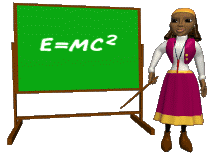The past couple years have brought about a flurry of excitement, energy, drama and debate in the world of physics education, and in K-12 education in general. A lot of great information has been shared, and a lot of misinformation has also been distributed. As a teacher learning my way in this dynamically charged environment, I think it’s worthwhile to try and distill down some of the hotly-contested topics into what they mean for my classroom.

Let’s begin by taking a look at what is being said about some of these topics. First, the Khan Academy has been receiving substantial notoriety as of late, largely fueled by Bill Gates’ sponsorship. The Khan Academy began as a project by Sal Khan to create videos to assist his niece in her classes. In and of themselves, the physics videos can be a helpful review… if you look closely, you can, of course, find a number of opportunities for improvement as well as statements that may lead to misunderstandings, but there is definitely value here when used appropriately.
Second, the “Flipped Classroom” movement has been gaining notoriety of late, even though the concept has been in practice in many classrooms for many, many years. In its current implementation, the popularized version of the flipped classroom infers teachers creating video lectures for students to watch as their homework assignments outside of class, leaving more valuable in-class time for hands-on activities, active engagement, problem solving and practice where the teacher is available to coach and guide, etc. This, of course, has been a standard practice in literature classes for many, many years (read the book at home, discuss in class), but the implementation version with teacher-created videos is becoming more and more popular as the technology to create and share videos becomes more accessible. Further, the independence with which students can access differing information on their own timeline opens up further options for Mastery Learning, which can move the classroom toward an environment where students learn at their own pace.
Search the Internet and it doesn’t take long to find a wide variety of stances on these resources and how they are used. Taken to the extreme or over-popularized by the media, the true intent of these resources can quickly become distorted. As an example, some are calling for the use of video lectures to take the place of trained teachers in classrooms, “streamlining” education for all. This is a dangerous path to take, particularly in the realm of science, as “teaching is really about creating experiences that allow students to construct meaning,” according to Frank Noschese in his Action-Reaction blog, and backed up by volumes of physics education research (PER).
This does not mean, however, that the videos don’t have value. They can be a resource, a tool, to be used in conjunction with a number of other tools, methods, and strategies to optimize education for each and every student. Do video lectures by themselves build true understanding? Of course not! I think it’s obvious to anyone who has worked in education that building meaningful understandings and connections isn’t facilitated by a passive observation of a lecture, whether delivered through video or in person. However, using a short video to highlight key “take-away” concepts, reinforce basic applications, facts, formulas, and vocabulary, demonstrate problem-solving methodologies, or to provide a review or synopsis for those who need a refresher or missed a class or two can be a very effective way to individualize instruction to a student’s needs.
Three years ago I began creating videos for my Regents Physics classes, having completed a set of 80+ videos this year covering the entire Regents Physics curriculum (http://www.aplusphysics.com/courses/regents/videos/vid_index.html). My goal wasn’t to replace my classroom instruction or activities, but rather to provide another tool to help students be successful. These videos allow students who miss classes for various reasons to come back to class with a head start on their catch-up work. They also allow me to divert some of the less-effective (but occasionally necessary) direct instruction to “at-home” time, providing more in-class time for activities which build deeper understandings, such as our catapult projects, building of iPod speakers, and water bottle rockets, all which allow students to make connections across concepts and subjects, explore and analyze data to come to their own conclusions, and perhaps most importantly, foster confidence in independent learning. Finally, students have fed back that these videos can be a great refresher as material gets stale, or at times provides a different look at a given subject, helping solidify areas of confusion.
Last night, for example, I was floored to receive a letter in the mail from a student I’ve never met. In the letter, the student stated:
“Your videos helped me understand the questions we went over in class. I used your site to study for my midterm… and [now] more fully understand the topics.”
These videos, and others like them, are certainly not “the answer.” But receiving this unsolicited letter from a student in a district I’ve never visited affirmed for me that they can be a valuable resource, and even if it’s only helping out the occasional student, isn’t that really what our jobs are about — finding a way to reach as many students as possible?
There is no magic bullet in education. Effective instruction is a constant struggle to best meet the needs of ever-changing individual learners in a constantly changing society. Strategies that are effective one year may not be effective next year. Or methods that reach one student may not work for another student. It is our challenge to try and meet the needs of as many of our students as we can on a day-by-day basis, working to help all of our students reach their potential and succeed. Research has shown repeatedly that active learning and meaning-making provides deeper, longer-lasting understanding. History and experience have also taught us that there is a time and place for direct instruction, though few would argue it is a but a small component of a highly effective classroom.
Videos can be used effectively to help meet these needs in different ways for different students, and are in and of themselves neither completely good nor completely evil. Instead, they are yet another resource in a teacher’s arsenal. Given the tremendous variety of students and challenges we face every day as educators, I want access to each and every resource I can get my hands on.

